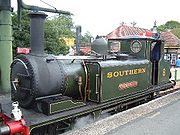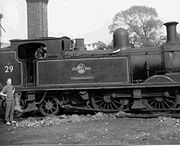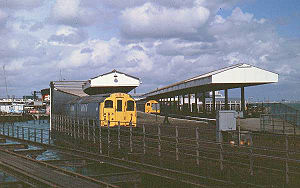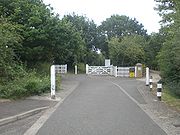
Railways on the Isle of Wight
Encyclopedia

There once existed a 55½ mile (89 km) network of railway lines on the Isle of Wight
Isle of Wight
The Isle of Wight is a county and the largest island of England, located in the English Channel, on average about 2–4 miles off the south coast of the county of Hampshire, separated from the mainland by a strait called the Solent...
. They were opened by several companies between 1862 and 1901, and all but the 8½ mile-long Island Line
Island Line, Isle of Wight
The Island Line is a railway line on the Isle of Wight, running some from Ryde Pier Head to Shanklin down the eastern side of the island. The line was electrified in 1967. Trains connect with passenger ferries to Portsmouth Harbour at Ryde Pier Head, and these ferries in turn connect with the...
closed between 1952 and 1966. A further 5½ miles have reopened as the Isle of Wight Steam Railway
Isle of Wight Steam Railway
The Isle of Wight Steam Railway is a heritage railway on the Isle of Wight. The railway passes through 5½ miles of unspoiled countryside from to station, passing through the small village of Havenstreet, where the line has a station, headquarters and a depot...
.
Early beginnings
The first railway to be built on the island ran for a distance of 2500 yards (2,286 m). It was opened in 1833 on the Nash Estate near YarmouthYarmouth, Isle of Wight
Yarmouth is a port and civil parish in the western part of the Isle of Wight, off the southern coast of mainland England. The town is named for its location at the mouth of the small Western Yar river...
. Its usage is presumed to have been for transporting brickmaking materials to and from a jetty on the Solent, and it is not thought to have used mechanical traction. The line is now abandoned.
The independent companies
The first conventional railway line to open on the island was that from Cowes to NewportNewport
Newport is a city and unitary authority area in Wales. Standing on the banks of the River Usk, it is located about east of Cardiff and is the largest urban area within the historic county boundaries of Monmouthshire and the preserved county of Gwent...
. The Cowes & Newport Railway Company began construction of the line in 1859 after an enabling Act of Parliament
Act of Parliament
An Act of Parliament is a statute enacted as primary legislation by a national or sub-national parliament. In the Republic of Ireland the term Act of the Oireachtas is used, and in the United States the term Act of Congress is used.In Commonwealth countries, the term is used both in a narrow...
was passed earlier that year. The line opened to passengers in June 1862.
Shortly after this, the Isle of Wight Railway
Isle of Wight Railway
The Isle of Wight Railway was a railway company on the Isle of Wight, United Kingdom. The company owned 14 miles of railway line and its headquarters were at Sandown...
(IWR) company built its initial line from Ryde to Shanklin
Shanklin
Shanklin is a popular seaside resort and civil parish on the Isle of Wight, England, located on the east coast's Sandown Bay. The sandy beach, its Old Village and a wooded ravine, Shanklin Chine, are its main attractions. The esplanade along the beach is occupied by hotels and restaurants for the...
, opening in 1864. Also in 1864, horse-drawn tram
Tram
A tram is a passenger rail vehicle which runs on tracks along public urban streets and also sometimes on separate rights of way. It may also run between cities and/or towns , and/or partially grade separated even in the cities...
s began running along Ryde Pier
Ryde Pier
Ryde Pier is an early 19th century pier serving the town of Ryde, on the Isle of Wight, off the south coast of England.- Before the pier :Before the pier was built, passengers to Ryde had the uncomfortable experience of coming ashore on the back of a porter and then, depending on the state of the...
, connecting ferry services to the town. The IWR opened an extension of its main line to reach Ventnor in 1866. In 1871, the Ryde tramway was extended to meet the railway line at Ryde St John's Road
Ryde St John's Road railway station
Ryde St John's Road is a railway station on the Island Line, and serves the town of Ryde, Isle of Wight. The station is south of Ryde Pier Head—the Island Line's northern terminus. When the station opened in 1864, it was known as Ryde railway station, as it was the northern terminus of the...
.
The Ryde & Newport Railway opened in December 1875, with operations controlled by the Cowes & Newport company.
In 1875, the Isle of Wight (Newport Junction) Railway opened the main part of its 10-mile Sandown to Newport line, planned in 1868. It would have opened sooner, but failed official inspections. In February 1875, the line was opened between Shide, a suburb of Newport, and the IWR station at Sandown. Eight months later the line was extended a further half mile to reach Pan Lane
Newport Pan Lane (Isle of Wight) railway station
Newport Pan Lane railway station, was, for four years, the temporary terminus of the Isle of Wight and Newport Junction Railway incorporated in 1868. Opened on 11 August 1875 and closed 4 years later on 1 June 1879 when the line was extended northwards to link with the new Newport Station...
. However, the final half-mile from there to Newport station did not open until 1879. Four years of poor connections in Newport meant not enough passengers or freight had been attracted to the line, and the company passed into receivership in 1880. At this point, it was bought by the Cowes & Newport/Ryde & Newport company, who were legally re-named as the Isle of Wight Central Railway
Isle of Wight Central Railway
The Isle of Wight Central Railway was a railway company on the Isle of Wight, United Kingdom. At its peak the company owned 21½ miles of railway line, and it also operated trains on some additional lines it did not own. Trains were first run on what became its lines in 1862, although the company...
.
In 1877 the London, Brighton and South Coast Railway
London, Brighton and South Coast Railway
The London, Brighton and South Coast Railway was a railway company in the United Kingdom from 1846 to 1922. Its territory formed a rough triangle, with London at its apex, practically the whole coastline of Sussex as its base, and a large part of Surrey...
and London and South Western Railway
London and South Western Railway
The London and South Western Railway was a railway company in England from 1838 to 1922. Its network extended from London to Plymouth via Salisbury and Exeter, with branches to Ilfracombe and Padstow and via Southampton to Bournemouth and Weymouth. It also had many routes connecting towns in...
were granted an Act of Parliament to extend Ryde Pier
Ryde Pier
Ryde Pier is an early 19th century pier serving the town of Ryde, on the Isle of Wight, off the south coast of England.- Before the pier :Before the pier was built, passengers to Ryde had the uncomfortable experience of coming ashore on the back of a porter and then, depending on the state of the...
, building a railway line from the pier head
Ryde Pier Head railway station
Ryde Pier Head railway station is one of three stations in the town of Ryde on the Isle of Wight. Situated at the end of the town's pier, it is adjacent to the terminal for the Wightlink fast catamaran service connecting the island with Portsmouth on the UK mainland...
to St John's Road. This was complete in 1880, and at this point the Ryde tramway was shortened to simply run along the pier.
In 1882, the IWR opened a branch line from Brading to Bembridge, serving a large natural harbour between Bembridge and St Helen's stations. A short-lived train ferry from Bembridge Harbour to the Hayling Island branch also started at this point.

The network was completed by the Newport, Godshill and St Lawrence Railway's Ventnor West branch
Ventnor West branch
The Ventnor West branch was the final addition to the Isle of Wight railway network, and utilised an earlier scheme to run a railway from Shanklin to the railwayless south-west part of the island.- History :...
line from Merstone, on the Sandown-Newport line, to St Lawrence on the south coast. This was opened in 1897, and extended to Ventnor West
Ventnor West railway station
Ventnor West railway station was opened on 1 June 1900 as the final addition to the railway network on the Isle of Wight. It was originally opened as Ventnor Town but the station was renamed in 1923 by the Southern Railway.- Location :...
in June 1900. This line, the last to be built on the island, was taken over by the Isle of Wight Central.
By the end of 1900, a total of 55½ miles of railway covered the island, including railway lines on Ryde Pier
Ryde Pier
Ryde Pier is an early 19th century pier serving the town of Ryde, on the Isle of Wight, off the south coast of England.- Before the pier :Before the pier was built, passengers to Ryde had the uncomfortable experience of coming ashore on the back of a porter and then, depending on the state of the...
(but excluding the pier tramway).
A fixed railway link to the mainland was authorised by Parliament in 1903. The South West and Isle of Wight Junction Railway was a joint project between the London & South Western Railway and the FYN. The excavation of a two and a half-mile long tunnel was approved in 1903, 1904 and 1909. However, the tunnel project was abandoned due the outbreak of the First World War in 1914.
As mentioned above, the IWCR and FYN had an agreement whereby the IWCR would provide the train service along the FYN line. However, in 1913 this agreement deteriorated to the point that the FYN was forced to purchase its own locomotives and rolling stock.
Southern Railway

Railways Act 1921
The Railways Act 1921, also known as the Grouping Act, was an enactment by the British government of David Lloyd George intended to stem the losses being made by many of the country's 120 railway companies, move the railways away from internal competition, and to retain some of the benefits which...
came into force from January 1923, the Southern Railway
Southern Railway (Great Britain)
The Southern Railway was a British railway company established in the 1923 Grouping. It linked London with the Channel ports, South West England, South coast resorts and Kent...
took over all lines on the island, although the integration of the FYN took some time due to financial wrangling. The company set about significant investment in the island's rail services, primarily through replacing old locomotives and carriages. Twenty-three O2 Class
LSWR O2 Class
The LSWR O2 Class is a class of 0-4-4T steam locomotive designed for the London and South Western Railway by William Adams. Sixty were constructed during the late nineteenth century.-Background:...
locomotives were transferred to the island from the former London and South Western Railway
London and South Western Railway
The London and South Western Railway was a railway company in England from 1838 to 1922. Its network extended from London to Plymouth via Salisbury and Exeter, with branches to Ilfracombe and Padstow and via Southampton to Bournemouth and Weymouth. It also had many routes connecting towns in...
's suburban services, and many coaches were brought from the former London, Chatham and Dover Railway
London, Chatham and Dover Railway
The London, Chatham and Dover Railway was a railway company in south-eastern England from 1859 until the 1923 grouping which united it with other companies to form the Southern Railway. Its lines ran through London and northern and eastern Kent to form a significant part of the Greater London...
and London, Brighton and South Coast Railway
London, Brighton and South Coast Railway
The London, Brighton and South Coast Railway was a railway company in the United Kingdom from 1846 to 1922. Its territory formed a rough triangle, with London at its apex, practically the whole coastline of Sussex as its base, and a large part of Surrey...
. The locomotives were given numbers under an unusual system where each number was individual only on the island. Each locomotive officially carried its number with a W-prefix to indicate this, and was given a nameplate relating to somewhere on the island (eg W 24—Calbourne).
The Southern also carried out changes in track layout to make services more flexible, such as the installation of double track from Brading to Sandown, new passing loops at Havenstreet
Havenstreet railway station
Haven Street railway station opened in 1875 and was an intermediate stop on the Ryde and Newport Railway, Isle of Wight Central Railway, Southern Railway and British Rail-being renamed Havenstreet in 1958...
and Wroxall
Wroxall railway station
Wroxall railway station was an intermediate station on the Isle of Wight Railway line from Ryde, situated between Shanklin and Ventnor with an upland situation...
stations, and pointwork at Smallbrook Junction. A new named train called The Tourist
The Tourist (train)
The Tourist was a train run by the Southern Railway on the railway lines of the Isle of Wight. It was set up in 1933 as an extension on the original East and West Through Train from the previous year...
was set up, running from Ventnor to Freshwater via Sandown, Merstone and Newport. It was the only named train on the island, and travelled on lines from all the former Isle of Wight railway companies.
Nationalisation, privatisation and preservation

The line between Ryde and Shanklin was also earmarked for closure by Beeching
Richard Beeching
Richard Beeching, Baron Beeching , commonly known as Doctor Beeching, was chairman of British Railways and a physicist and engineer...
, but management decided to authorise electrification
Electrification
Electrification originally referred to the build out of the electrical generating and distribution systems which occurred in the United States, England and other countries from the mid 1880's until around 1940 and is in progress in developing countries. This also included the change over from line...
instead. This remaining Ryde-Shanklin line
Island Line, Isle of Wight
The Island Line is a railway line on the Isle of Wight, running some from Ryde Pier Head to Shanklin down the eastern side of the island. The line was electrified in 1967. Trains connect with passenger ferries to Portsmouth Harbour at Ryde Pier Head, and these ferries in turn connect with the...
was electrified using the third rail
Third rail
A third rail is a method of providing electric power to a railway train, through a semi-continuous rigid conductor placed alongside or between the rails of a railway track. It is used typically in a mass transit or rapid transit system, which has alignments in its own corridors, fully or almost...
system and Class 485
British Rail Class 485
The British Rail Class 485 and British Rail Class 486 electrical multiple units were original built for the London Electric Railway from 1923-31 as their 'Standard' tube stock...
and Class 486 trains, which had previously worked on the London Underground
London Underground
The London Underground is a rapid transit system serving a large part of Greater London and some parts of Buckinghamshire, Hertfordshire and Essex in England...
. The new electric service began in March 1967.
In 1971, the Isle of Wight Steam Railway
Isle of Wight Steam Railway
The Isle of Wight Steam Railway is a heritage railway on the Isle of Wight. The railway passes through 5½ miles of unspoiled countryside from to station, passing through the small village of Havenstreet, where the line has a station, headquarters and a depot...
began operating on part of the Ryde to Newport line. Their operation extended to reach 5½ miles in 1991, and they are now focused on restoring their substantial fleet of historic carriages.

British Rail Class 483
The British Rail Class 483 electrical multiple units were originally built as 1938 tube stock units for London Underground. They were extensively refurbished between 1989 and 1992 by Eastleigh Works, for use on services on the Isle of Wight's Island Line. This was despite having already worked for...
trains replaced the older electric units on the Ryde-Shanklin line. The line and passenger services were branded
British Rail brand names
British Rail was the brand image of the nationalised railway owner and operator in Great Britain, the British Railways Board, used from 1965 until its breakup and sell-off from 1993 onwards....
as Island Line (replacing the former RydeRail brand), and in 1996 the passenger service was privatised as the Island Line franchise, which was absorbed into the South Western franchise in 2007. Since then, electric services on the line have continued to run under the name Island Line Trains.
Fate of the abandoned lines

Wightbus route 16
Wightbus route 16 or the Rail link service was a bus service operated on the Isle of Wight by Wightbus between St Lawrence and Shanklin via Ventnor Botanic Garden, Ventnor and Bonchurch...
bus from Shanklin, although this was withdrawn in 2010. Newport railway station
Newport railway station (IoWCR Isle of Wight)
Newport railway station was established in 1862 with the opening of the Cowes and Newport. It was enlarged in December 1875 when the lines to Ryde and Ventnor were opened. The station was also used by the Freshwater, Yarmouth and Newport Railway from its opening in 1888 until 1913, when that...
was completely demolished in 1971 to make way for an upgrade of the A3054 road
A3054 road
The A3054 is an A-Class Road on the Isle of Wight in Southern England. It forms the Northern half of the circular around-the-Island A-class loop, the southern half being the A3055...
. Most of the network has been turned into "rail trail
Rail trail
A rail trail is the conversion of a disused railway easement into a multi-use path, typically for walking, cycling and sometimes horse riding. The characteristics of former tracks—flat, long, frequently running through historical areas—are appealing for various development. The term sometimes also...
" cyclepaths, and notably the island's section of National Cycle Route 23 was constructed mainly on the former Sandown-Newport-Cowes line of the Isle of Wight Central Railway
Isle of Wight Central Railway
The Isle of Wight Central Railway was a railway company on the Isle of Wight, United Kingdom. At its peak the company owned 21½ miles of railway line, and it also operated trains on some additional lines it did not own. Trains were first run on what became its lines in 1862, although the company...
. However, much of the former Merstone–Ventnor West and FYN lines have no public access, the main exception being the route between Yarmouth and Freshwater.
The future
The future of the railways is secure until 2017, when the existing National RailNational Rail
National Rail is a title used by the Association of Train Operating Companies as a generic term to define the passenger rail services operated in Great Britain...
South Western franchise runs out. There are numerous plans for the island's rail system, including:
- the extension of steam services from Smallbrook Junction to Ryde St John's Road station
- conversion of the Island Line to a tramway and extending into Shanklin town centre
- extension of steam railway to reach Newport
- extension of Island Line into Ventnor along the old route (first considered in 1967)
- extension of the Island Line to GosportGosportGosport is a town, district and borough situated on the south coast of England, within the county of Hampshire. It has approximately 80,000 permanent residents with a further 5,000-10,000 during the summer months...
, HampshireHampshireHampshire is a county on the southern coast of England in the United Kingdom. The county town of Hampshire is Winchester, a historic cathedral city that was once the capital of England. Hampshire is notable for housing the original birthplaces of the Royal Navy, British Army, and Royal Air Force...
via a new SolentSolentThe Solent is a strait separating the Isle of Wight from the mainland of England.The Solent is a major shipping route for passengers, freight and military vessels. It is an important recreational area for water sports, particularly yachting, hosting the Cowes Week sailing event annually...
tunnel

